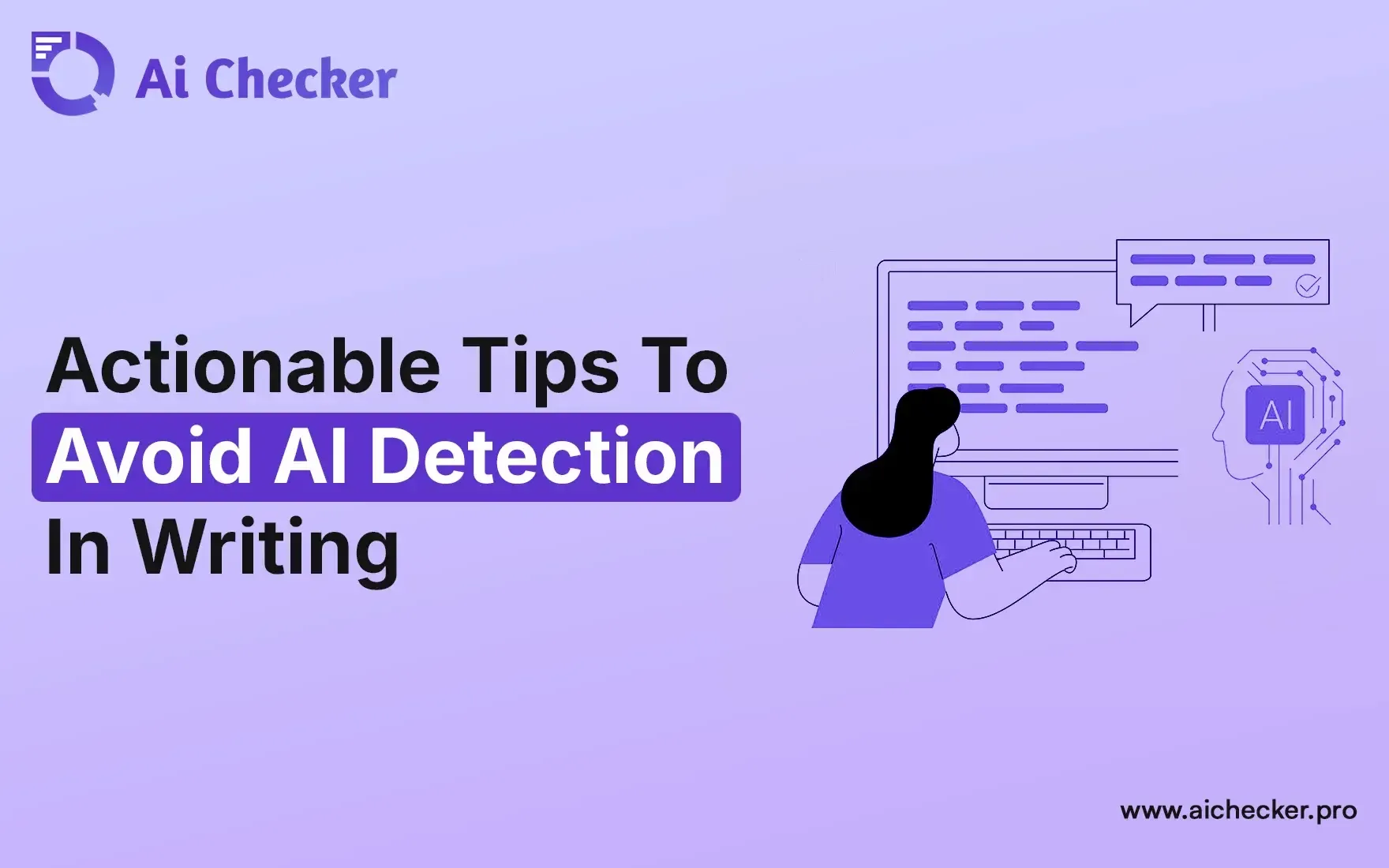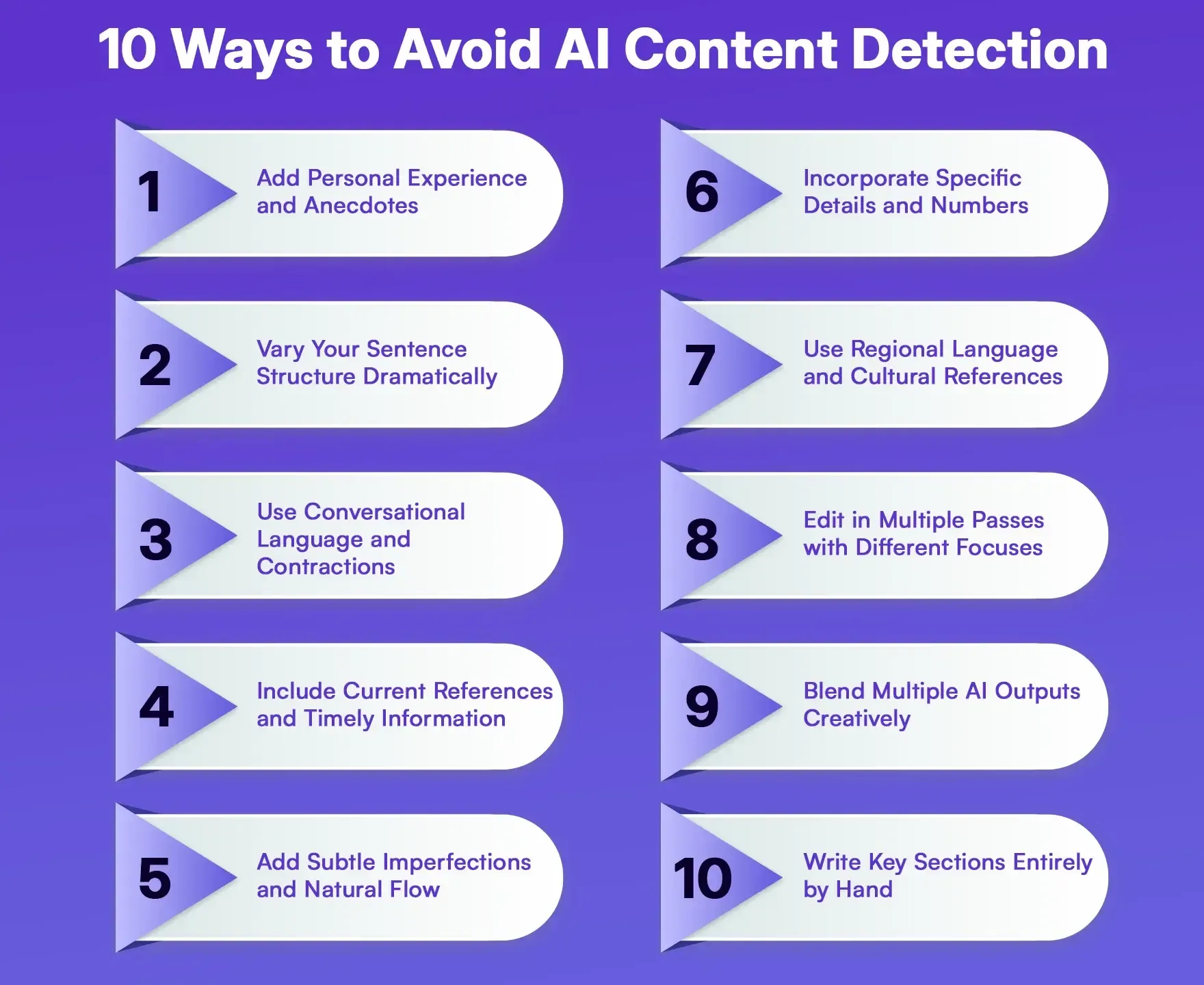Sign In
Welcome to AI Checker Sign in to continue your exploration of our platform with all its exciting features.
Forgot Password?
Don’t have an account ? Sign Up
Forgot Password
We'll Send You An Email To Reset Your Password.
Back to Login
Sign Up
Embrace the Future with AI Checker Sign up now and let's rewrite the possibilities together.
Already have an account? Sign In
Enter OTP
We'll send you an email to reset your password.
Back to Login
Enter OTP
We'll send you an OTP on your registered email address.
Back to Login
Confirm Password
Please enter your new password.
10 Actionable Tips To Avoid AI Detection In Writing
 Nathan Porter
Nathan Porter
TABLE OF CONTENTS
What is AI Detection?
What are AI Detection Tools?
Can AI Detectors Identify AI-Generated Content?
10 Ways to Avoid AI Content Detection
Can Google Detect AI Content?
Should You Hide AI Content?
When Should You Avoid Using AI Content?
Key Takeaways
Conclusion
FAQs
As a person who has spent many years on a journey in digital content creation, I have seen firsthand the growth of the tools used to detect AI-generated content. So it does not matter if you are a content creator, a college student, or an author; working with AI has become an essential digital literacy skill.
What is AI Detection?
AI detection identifies whether content is generated by an AI or a human. The reader should think of it in a similar fashion to a digital fingerprint scanner for writing. You can sometimes tell when people are reading from a script versus speaking, and AI detectors check the writing by looking for consistent patterns.
AI Detection systems utilize various types of linguistic markers that AI models typically generate. I can recall that when I started working with AI writing tools, I was surprised by the subtle nature of these patterns; things like sentence structure and word choice frequency, and punctuation patterns can give AI-generated content away.
What are AI Detection Tools?
AI detection tools are software programs that are programmed to analyze text in order to determine the possibility that it was created using artificial intelligence. Some of the most common AI detectors are Assignmentgpt.ai, Bypassai.io, Originality.ai, Winston AI, GPTZero, Copyleaks, and ZeroGPT.
Based on some testing done in 2025, Originality.ai and Winston AI appear to be two of the most accurate AI detectors, each performing well against detection accuracy. These tools have become instrumental for educators, publishers, and content managers who need to authenticate written work.
From my own experience with these tools, they each have their own strengths. Some are better at detecting a paraphrased instance, while others can detect specific AI models like GPT-4 or ChatGPT.
Can AI Detectors Identify AI-Generated Content?
The short answer is: sometimes, but not always. AI detectors are not 100% reliable, and it is possible for human writers to be misidentified. When a human writer is erroneously flagged, that is referred to as "false positives," which can happen more frequently than you might think.
Some studies say AI detection tools are more likely to falsely identify text generated by GPT 3.5 as AI content than texts generated by GPT 4, which suggests an important finding: as AI models grow in sophistication, it becomes more difficult to catch that the AI detection accuracy falls apart.
Through my testing comprised a multitude of detectors, it seems that accuracy levels can really vary by the type of content, length of text, and the specific model that generated it. Copyleaks claims an accuracy of greater than 99% with a false positive rate of 0.2%, but I often found that even with claimed statistics, real-world performance varies.
10 Ways to Avoid AI Content Detection
Based on my extensive experience working with both AI writing tools and detection systems, here are ten actionable strategies that can help make AI-generated content less detectable:

1\. Add Personal Experience and Anecdotes
The best way I know to instantly humanize AI content is to incorporate personal experiences. Nobody has the same lived experiences as you, and by including truthful stories, personal examples from your work, or observations from your life, you can personalize the content immediately. I always ask myself - When I edit AI content - "What can I add from my experience?"
2\. Vary Your Sentence Structure Dramatically
AI models often conform to familiar patterns of sentence construction, so tear apart those patterns by purposely varying the length of your sentences. Write some short, punchy sentences and leave the reader with an impact. Write some longer, complex sentences and leave the reader nothing but confused. Write fragments, combine clauses into longer sentences that are still flowing, but can be entirely unpredictable.
3\. Use Conversational Language and Contractions
Formal AI writing often avoids contractions and maintains a consistent tone. Combat this by using "don't," "won't," "I've," and other contractions naturally. Write as if you're explaining something to a friend over coffee rather than presenting to a board room.
4\. Include Current References and Timely Information
AI models have training cutoffs, so referencing very recent events, current trends, or newly released knowledge can signal human involvement. When I write and edit AI content, I always make an effort to incorporate something in my content that has occurred in the past few months.
5\. Add Subtle Imperfections and Natural Flow
Having flawless grammar and flawless transitions may actually cause you to lose an audience. Humans write naturally with unnecessary run-on sentences, weird grammatical idiosyncrasies, and thoughts that don't transfer or transition perfectly. Don't go too far, but just a smidge of imperfection helps.
6\. Incorporate Specific Details and Numbers
Substituting "many people" for either specific statistics, dates, or examples is crucial. "Recent studies" as borrowed language is often weak and vague, and AI tends not to favor specificity. Being specific is your friend. When referencing research, be sure to include an actual published study with dates.
7\. Use Regional Language and Cultural References
AI models that have been trained with global datasets are likely to produce outputs that are generic and culturally neutral at best. Using localized expressions, cultural references that make sense in your region, or current industry-specific jargon, allows you to create authenticity.
8\. Edit in Multiple Passes with Different Focuses
Don't ever publish AI content, unedited. I suggest at least three editing passes: the first to check for content validity, the second for voice/tone consistency, and the third for fluidity and readability. Each editing pass should modify the AI's original output significantly.
9\. Blend Multiple AI Outputs Creatively
Instead of using a single AI-generated piece, create content by combining outputs from different prompts or even different AI tools, then weave them together with your own transitions and ideas. This creates a more complex pattern that's harder for detectors to identify.
10\. Write Key Sections Entirely by Hand
Choose the most important paragraphs – typically the introduction, conclusion, and main argument sections – and write these completely yourself. Use AI for research, ideation, or rough drafts, but ensure the core message comes from your own writing style.
Can Google Detect AI Content?
This is perhaps the most important question for content creators and SEO professionals. The relationship between Google and AI content is nuanced and evolving.
Google does not penalize AI content according to its policies. However, Google recently applied manual actions on websites using spammy, AI-generated content. Google's guidelines focus on content that attempts to "game search engine rankings" and "manipulate ranking in search results," emphasizing instead that creators should focus on "content created primarily for people".
Google's quality raters now assess whether content is AI-generated, which indicates that Google is actively monitoring AI content usage. However, Google's algorithms are increasingly sophisticated and consider factors including writing style, coherence, and contextual accuracy rather than simply flagging all AI content.
The key insight I've gathered from working in SEO is that Google cares more about content quality and user value than the method of creation. High-quality, helpful AI content that serves users well is less likely to face penalties than low-quality human content.
Should You Hide AI Content?
This question raises topics like ethics and transparency, but also more practical aspects. In my opinion, there are contextual and purpose-driven reasons for the approach.
For academic or journalistic purposes or any field where authorship integrity matters, it is becoming standard practice and is also required more and more to disclose AI assistance. Many institutions have an AI policy, specifically mentioning the requirement for disclosure in uses of AI.
For content marketing, blogging, and just web content in general, I would focus on delivering value and not how it was created. However, being honest about the assistance you received with AI in creating content, if it is a meaningful part of your content, can help build trust with your audience.
In my experience as a content creator, audiences tend to embrace honesty about collaborating with AI, especially when you are up front about how you use it as a tool but still maintain ownership and control, as well as expertise in the editorial role.
When Should You Avoid Using AI Content?
Through my experience, I've identified several scenarios where AI content is inappropriate or risky:
Academic and Research Settings : Many educational institutions have policies prohibiting the use of AI. Always check and follow your institutional policies. Original research, thesis work, and peer-reviewed publications typically require authorship by humans.
Professional Certifications/Licenses/Credits : Many professions require original work (e.g., for certifications, licensing exams, continuing education credits). Utilizing AI in these contexts could violate professional ethics standards.
Legal Writing : Legal writing requires precision, accountability, and professional liability that AI cannot provide. Lawyers and legal professionals should avoid using AI for official documents, contracts, or court filings.
Written Communications : Emails, cover letters, and personal statements should be in your voice and in your thoughts, unless you are using AI to help with structure or grammar in your documents. The original writing can and should be yours.
Client Work Without Disclosure : If you are completing writing for clients, it is crucial to be transparent with your process, as many clients are specifically seeking human content, and you should disclose the process you undertook to fulfill their request.
Time-Sensitive or Breaking News Articles : AI models are sourced from past data, and the data they were trained on has a cutoff. AI cannot reliably access real-time information. If you are writing on recent events or breaking news, human research and verification are needed.
Key Takeaways
After several years working with both AI writing tools and detection tools, here are my most important reminders:
Quality and value should always be the goal above how the content was produced. AI detection tools are sophisticated, but they are not flawless, and they are still developing alongside AI writing tools. Recent surveys found that over 52% of US adults are using large language models such as ChatGPT. That may be the widest and fastest adoption of a technology ever.
The goal should not be to avoid detection entirely; it should be to produce content that serves your audience well, ethically, while also combining both the efficiency of the AI with creativity, expertise, and authenticity.
Google and other search engines are more focused on user satisfaction, content quality, as opposed to how the content was created. Although there are penalties for spammy AI content or manipulative use of AI, if your content is valuable, that is the focus. Always start by providing your audience value, and never focus on whether the search engines will perceive manipulative intent.
The use of AI tools is only going to continue to increase, and as it becomes more mainstream, transparency and ethical use will become more and more important. In the end, if you can build trust by openly discussing what you did and how you did it, that is a better long-term strategy than lying about AI assistance.
Conclusion
The developments in AI detection and creation are progressing at a rapid pace. As someone who has also seen these changes through the lens of a professional, I think that the world will belong to those creators who can combine the efficiency of AI with the value of human intuition and authenticity.
Rather than viewing AI detection as an obstacle to navigate, think of it more as a challenge to keep your standards and your value ratios authentic and high, as a creator. The challenge is not to avoid detection altogether; the challenge is to create value, regardless of AI detection, or the first-generation detection of AI content.
Remember that AI is extremely powerful, but it is just a tool. Your knowledge, experience, and point of view are what turn text generated by AI into valuable content. Use these ten strategies not just to avoid detection, but to create more valuable and authentic content for your audience.
The goal should never be to deceive, instead, the goal is to create authentic and interesting content utilizing the power of the best aspects of human imagination and AI technology. As the technology continues to evolve, those who can navigate the landscape will be in a better position to benefit from whatever scenario arises as these foundational tools continue to evolve.
FAQs
1. Can AI detectors reliably identify AI-generated content?
No, they often produce false positives and struggle with advanced models like GPT-4.
2. What are the best AI detection tools in 2025?
Originality.ai and Winston AI lead in accuracy, but performance varies by content type.
3. Does Google penalize AI-generated content?
Google prioritizes quality over origin but penalizes spammy or manipulative AI content.
4. How can I make AI content sound more human?
Add personal anecdotes, vary sentence structure, and use conversational language.
5. Is disclosing AI use necessary?
Yes, in academic/journalistic contexts, for marketing, focus on value, but transparency builds trust.
6. When should I avoid using AI-generated content?
In legal documents, academic submissions, breaking news, or client work requiring human authorship.
7. Why do AI detectors flag human writing?
Overly polished grammar or predictable patterns can trigger false positives.

Nathan Porter
Content writer at @Aichecker
I am a content writer at AI Checker Pro, where I craft engaging, SEO-optimized content to enhance brand visibility and educate users about our AI-driven solutions. My role involves creating clear, impactful messaging across digital platforms to drive engagement and support company growth.



